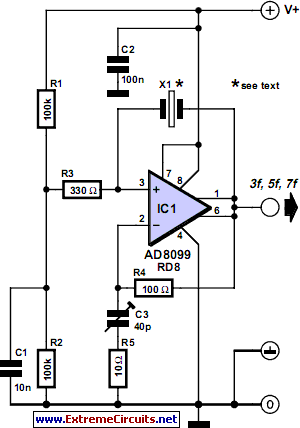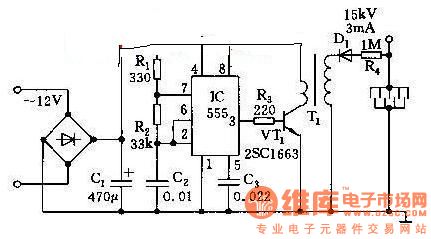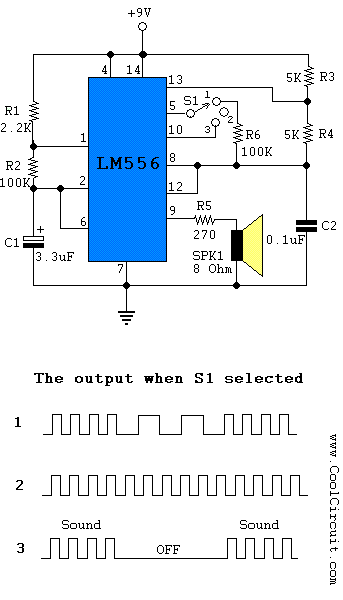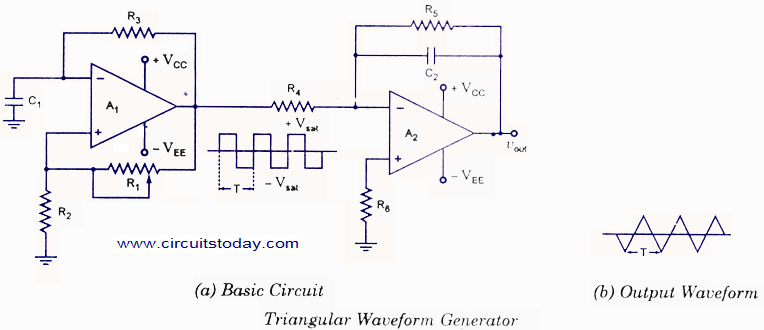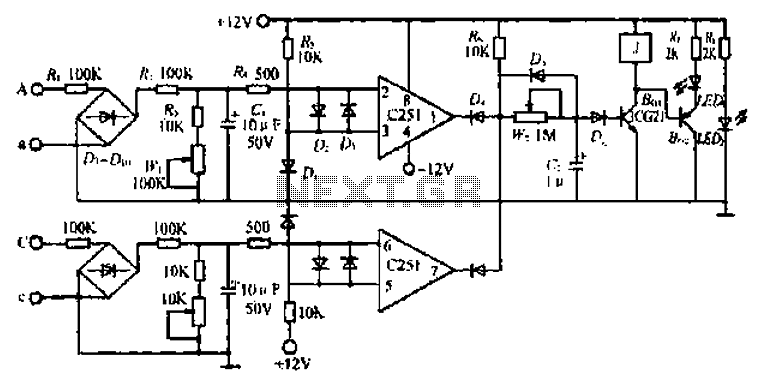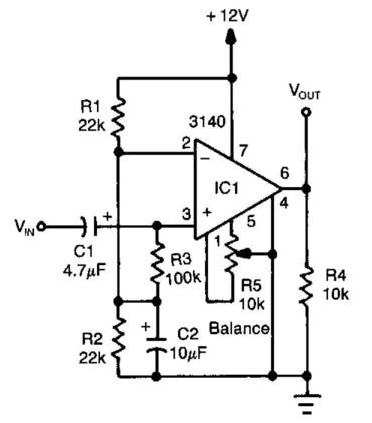
Lc Sine-Wave Generator
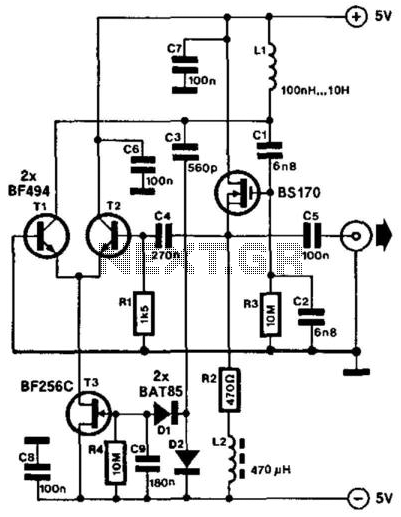
This compact LC oscillator operates within a frequency range of approximately 1 kHz to nearly 9 MHz and provides a low-distortion sine-wave output. The core of the circuit consists of a series-resonant circuit formed by inductor L1 and capacitors C2 and C3, which are integrated into the feedback loop of the amplifiers T1 and T2. Transistor T2 functions as an emitter follower, acting as an impedance converter, while transistor T1, configured in a common base arrangement, serves as a voltage amplifier. The amplification provided by T1 is influenced by the impedance of L1 within its collector circuit and the emitter current. The feedback loop is established from the collector of T1 through the junction of the capacitive divider formed by C1 and C2, followed by the source follower BS170. The input impedance is defined by resistor R1 and capacitor C4. This configuration bears a strong resemblance to a Colpitts oscillator. The output signal is routed to the output terminal through capacitor C5. Notably, the amplitude control is managed by a current source. The output signal is rectified using two Schottky diodes, smoothed by capacitor C9, and subsequently utilized to regulate the current flowing through transistor T3. As a result, the gain of amplifier T1 is greater at lower input levels compared to higher input levels. This design minimizes distortion, as the amplifier is prevented from being overdriven. With the specified component values, the oscillator frequency ranges from 863 Hz (with a 10 µH inductor) to 8.630 MHz (with a 100 µH inductor). The circuit can also be employed to measure the Q factor of inductors. To facilitate this measurement, a potentiometer is connected in parallel with L1 and adjusted to double the current through the amplifier.
The compact LC oscillator circuit is designed to generate a stable sine wave output across a broad frequency spectrum, making it suitable for various applications, including signal generation and testing. The series-resonant circuit configuration ensures that the desired frequency can be precisely tuned by adjusting the values of L1, C2, and C3. The use of a common base amplifier configuration for T1 allows for high-frequency operation with minimal phase shift, which is crucial for maintaining signal integrity at high frequencies.
The feedback mechanism implemented in this oscillator is critical for sustaining oscillation. The capacitive divider formed by C1 and C2 plays a pivotal role in determining the feedback ratio, which directly influences the oscillator's stability and output amplitude. The incorporation of a source follower (BS170) further enhances the circuit's performance by isolating the feedback network from the output stage, preventing loading effects that could destabilize the oscillation.
The amplitude control feature is particularly noteworthy, as it allows for dynamic adjustment of the output signal level. By rectifying the output and using it to control the biasing of T3, the circuit can adaptively respond to varying input signal levels, ensuring consistent output quality without distortion. This is particularly beneficial in applications where signal integrity is paramount.
The capability to measure the Q factor of inductors adds versatility to the circuit. The adjustment of the potentiometer in parallel with L1 allows for precise tuning of the circuit's response to the inductor being tested, providing valuable insights into its quality and performance characteristics. Overall, this compact LC oscillator circuit exemplifies a well-engineered solution for generating low-distortion sine waves and measuring inductive components effectively. This compact LC oscillator offers a frequency range of about 1 kHz to almost 9 MHz and a low-distortion sine-wave ou tput. The heart of the circuit is series-resonant circuit L1/C2/C3 in the feedback loop of amplifiers T1/T2. Transistor T2, which is connected as an emitter follower, serves as impedance converter, whereas Tl, connected to a common base circuit, is a voltage amplifier whose amplification is determined by the impedance of LI in its collector circuit and the emitter current.
The feedback loop runs from the collector of Tl via the junction of capacitive divider C1/C2, source-follower BS170, and the input impedance is formed by R1/C4, The whole is strongly reminiscent of a Colpitis circuit. The signal is also taken to the output terminal via C5. Of particular interest is the amplitude control by the current source. The signal is rectified by two Schottky diodes, smoothed by C9, then used to control the current through T3.
The gain of amplifier Tl is therefore higher at low input levels than at higher ones. This arrangement ensures very low distortion, because the amplifier cannot be overdriven. With values as shown, it extends from 863 Hz ( = 10 H) to 8.630 MHz (^=100 H). The unit can be used to measure the Q of inductors. To that end, a potentiometer is connected in parallel with LI and adjusted so that the current through the amplifier is doubled. 🔗 External reference
The compact LC oscillator circuit is designed to generate a stable sine wave output across a broad frequency spectrum, making it suitable for various applications, including signal generation and testing. The series-resonant circuit configuration ensures that the desired frequency can be precisely tuned by adjusting the values of L1, C2, and C3. The use of a common base amplifier configuration for T1 allows for high-frequency operation with minimal phase shift, which is crucial for maintaining signal integrity at high frequencies.
The feedback mechanism implemented in this oscillator is critical for sustaining oscillation. The capacitive divider formed by C1 and C2 plays a pivotal role in determining the feedback ratio, which directly influences the oscillator's stability and output amplitude. The incorporation of a source follower (BS170) further enhances the circuit's performance by isolating the feedback network from the output stage, preventing loading effects that could destabilize the oscillation.
The amplitude control feature is particularly noteworthy, as it allows for dynamic adjustment of the output signal level. By rectifying the output and using it to control the biasing of T3, the circuit can adaptively respond to varying input signal levels, ensuring consistent output quality without distortion. This is particularly beneficial in applications where signal integrity is paramount.
The capability to measure the Q factor of inductors adds versatility to the circuit. The adjustment of the potentiometer in parallel with L1 allows for precise tuning of the circuit's response to the inductor being tested, providing valuable insights into its quality and performance characteristics. Overall, this compact LC oscillator circuit exemplifies a well-engineered solution for generating low-distortion sine waves and measuring inductive components effectively. This compact LC oscillator offers a frequency range of about 1 kHz to almost 9 MHz and a low-distortion sine-wave ou tput. The heart of the circuit is series-resonant circuit L1/C2/C3 in the feedback loop of amplifiers T1/T2. Transistor T2, which is connected as an emitter follower, serves as impedance converter, whereas Tl, connected to a common base circuit, is a voltage amplifier whose amplification is determined by the impedance of LI in its collector circuit and the emitter current.
The feedback loop runs from the collector of Tl via the junction of capacitive divider C1/C2, source-follower BS170, and the input impedance is formed by R1/C4, The whole is strongly reminiscent of a Colpitis circuit. The signal is also taken to the output terminal via C5. Of particular interest is the amplitude control by the current source. The signal is rectified by two Schottky diodes, smoothed by C9, then used to control the current through T3.
The gain of amplifier Tl is therefore higher at low input levels than at higher ones. This arrangement ensures very low distortion, because the amplifier cannot be overdriven. With values as shown, it extends from 863 Hz ( = 10 H) to 8.630 MHz (^=100 H). The unit can be used to measure the Q of inductors. To that end, a potentiometer is connected in parallel with LI and adjusted so that the current through the amplifier is doubled. 🔗 External reference
